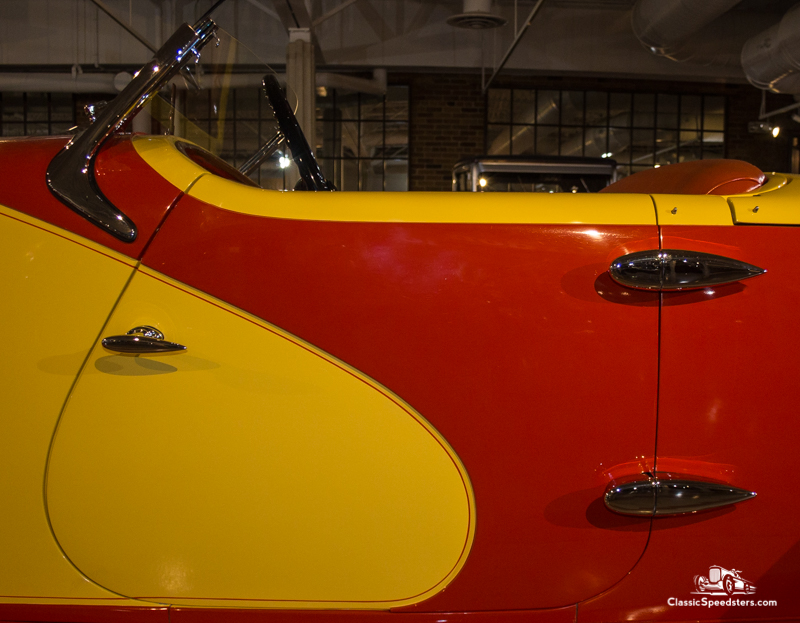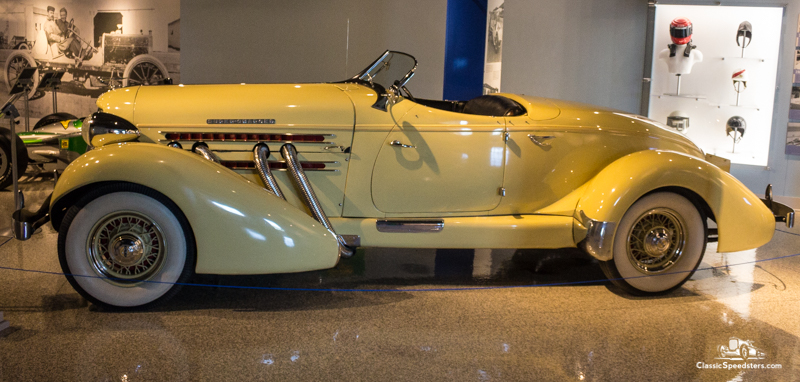When one considers advances in automotive design and technology, the 1920s and early 1930s served up some of the world’s greatest automobiles. Along with the outsized economic expansion of the 1920s, designers stepped up to create factory-built (customs) and privately-built (coachbuilt) luxury cars for the newly monied crowds, those whose wealth had mushroomed with the boom times. Specially designed luxury cars were created for these clients to go to the opera, to the country club, or to the country home. The period between 1925-1935 represents what many consider the Golden Decade of the luxury automobile, and speedsters were among that group.
1931 Cord L-29 Speedster, ACD Museum
To augment the luxurious cruising and traveling models offered by automobile firms, “luxo” speedsters were also produced in limited quantities by many firms as a lure to bring the crowds into their showrooms.
1929 Stutz Black Hawk Speedster courtesy AACA Library
Sometimes luxo speedsters were offered up as a loss-leader to attract attention, and sometimes were produced as a serious addition to the company’s lineup, but these examples represented the epitome of current thought on what made a speedster. Aerodynamically–sculpted fenders, sharp-edged boattails, supercharged engines. These cars were big, avante-garde creations, but they still shouted adventure!
Luxo speedsters bore almost no resemblance to their older siblings of 10, or even, 20 years ago. Yet, when compared to their contemporaries, these speedsters adhered to the qualities of a “speedster” in that they were simpler in design, often lighter in execution, and had more powerful engines to motivate them. They not only fit the speedster definition, they were often named as such. However, these versions of the speedster genre were boulevardiers: cruisers meant to travel in style, look good, and let everyone one know that so-and-so had arrived.
The Kissel Automobile Company had offered a speedster in its lineup since 1918, and by 1927 had been producing a small number of very sophisticated and well-built speedsters. Using six-and eight-cylinder engines that produced up to 126 horsepower, and mounted on chassis from 125” to 139” in wheelbase, these were custom-built (at the factory) models that epitomized Old World craftsmanship.
1927 Kissel 8-90 Speedster courtesy Wisconsin Automotive Museum
Other automobile companies were producing luxo speedsters in their custom divisions that had been set up for small-batch production of such models. Auburn was one such example, and its run of speedsters, stretching from the 1928 Second Series Model 88 and 115 speedsters, to their last gasp with the 1936 Model 8-852 Supercharged Speedster, all of these examples were at the forefront of current design and technological innovation. They sported new technologies, like a free-wheeling option for economy, a dual ratio transaxle for more gear selection, and supercharging for more power; Auburn set speed records at places like Muroc Dry Lake and competed in stock car races during a time when the AAA raced real “stock” cars. Auburn speedsters were also drop-dead gorgeous!
1935 Auburn 851 Super-Charged Speedster, ACD Museum
As luxurious as the Auburn appears to us today, during the 1920s and 30s it was marketed as the moderately-priced car in the Cord Corporation’s Auburn-Cord-Duesenberg conglomerate, and as such Auburns were offered at very competitive prices. The Duesenberg Company had lagged and languished for most of the 1920s while its founding owners, the Duesenberg brothers, focused on Indianapolis-style racing. In 1926 Errett Lobban Cord purchased Duesenberg for a fire sale price to serve as the capstone of his automotive empire. The Duesenberg Model J series of cars that emerged from this union were designed to be the largest, the fastest, and the most luxurious American automobiles ever made. And they were!
E.L. Cord had intended to produce a car so over the top that America’s rich and famous would favor it over European offerings. Imagine that: an American luxury car that equaled or surpassed the best of the European luxury automobiles. That was Cord’s vision.
Duesenbergs were produced as rolling chassis, and famous coachbuilders such as Murray of Pasadena, Brewster of Long Island City, and Derham of Philadelphia created masterpieces that remain the best American cars ever made. Not to be ignored, European ateliers such as Figoni and Van den Plas proposed and produced examples for their clients. According to West Peterson, editor for Antique Automobile magazine, at least 29 coachbuilding firms, 14 American and 15 foreign, built on the Duesenberg chassis. Records exist to this day of the fewer that 500 Duesenberg chassis that were produced and their provenance so that the astute collector can determine what their car’s original outfit was. Several cars have, over the years, undergone body changes to jibe with the times and the owner’s changing needs; these records thankfully exist to tell the car’s history!
1932 Duesenberg Model J Torpedo Convertible Coupe Speedster, ACD Museum
A small group of ten Duesenbergs were produced and officially designated (ex-factory) as speedster models, but several others were described as “speedster” by designers, journalists, and everyday folks. Some were even sketched out for proposals that went no further. All of these examples represent the high points of designs inhabiting the “Golden Decade” for luxury cars!
de Villars Duesenberg speedster-roadster concept
courtesy National Automotive Collection, Detroit Public Library
Several other famous marques such as Packard, Marmon, and Stutz used their factory resources to have in-house custom-built speedsters created during this era of opulence. The exact number produced varied by company, but the actual number of speedsters was far less than the bread-and-butter sedans, phaetons, and limousines.
1930 Packard Series 734 Speedster Runabout courtesy William Bailey collection
The boom times of the 1920s had grown America’s wealth tremendously, yet all good things must come to an end. The 1930s national economy rolled off the road and on into a ditch as easy money disappeared in the years following the Great Depression of 1930. The coachbuilding industry, for all intents and purposes, withered from a dwindling list of clients and contracts.
Of the several books that chronicled this famous era in luxury automobile design, two stand out as must-reads. Olympian Cars by Richard Burns Carson (1976) gives a sweeping, yet comprehensive, overview of this famous historical period through the works of eighteen companies in the context of their time. The Coachbuilt Era by Hugo Pfau (1970) reveals an insider’s look at the luxury custom and coachbuilt phenomenon as seen from a designer who worked for LeBaron and later wrote about the era in the popular press. Pfau discussed famous American and European coachbuilders, as well as the automobile companies that used them.
Considering the vast resources of the Internet, www.Coachbuilt.com provides an excellent database on North American coachbuilders and their accomplishments. Another must-read.
The next several posts will showcase companies that built speedsters from the three generations that we have covered so far. Stay tuned!








